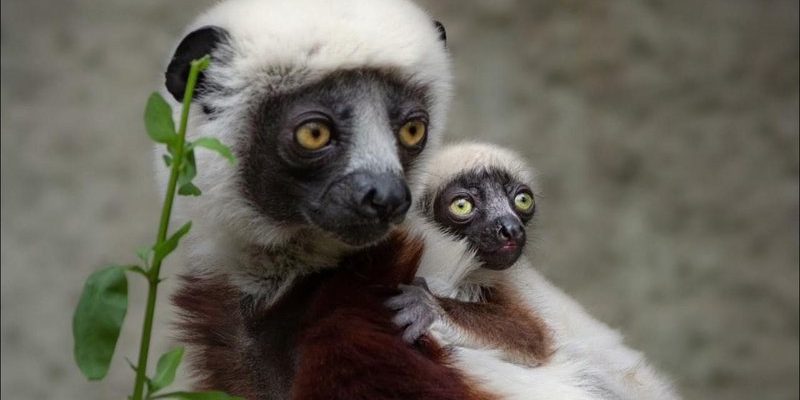![Comparing The Sifaka Vs. [Similar Species]](https://gudri.com/wp-content/uploads/2025/06/Comparing_The_Sifaka_Vs___Similar_Species__image_0.jpg)
Imagine the sifaka as a graceful dancer, leaping between branches with elegance. Then there’s the indri, more like a powerful vocalist, known for its distinctive calls that echo through the forest. Both animals provide incredible insights into the diversity of life on our planet, but they also face challenges that highlight the need for conservation. Here’s a closer look at these two amazing species.
Physical Characteristics
Both the sifaka and the indri have striking appearances, but they wear their looks quite differently. Starting with the sifaka, these lemurs are known for their long legs and arms, which help them leap through trees with astonishing agility. They typically have soft, creamy fur and large, expressive eyes that make them irresistibly cute. Depending on the species, their color can range from white to brown, often with unique patterns that add to their charm.
On the other hand, the indri is the largest living lemur, and boy, does it show! With a stocky build and shorter limbs compared to the sifaka, it’s not as agile in the air but makes up for it with power. The indri is mostly black and white, with a striking appearance that resembles a panda more than a typical lemur. Their large ears give them a distinctive look, almost like they’re always listening for something interesting in their treetop world.
Habitat and Distribution
The habitats of the sifaka and the indri overlap, but each has its preference for specific environments. The sifaka is versatile, found in both dry and humid forests across Madagascar. Their adaptability allows them to thrive in different surroundings, which is crucial as their habitats face deforestation and degradation.
Contrarily, the indri has a narrower habitat range. These curious creatures prefer humid rainforests and are often found in more stable, undisturbed environments. This focused preference makes them more vulnerable to habitat loss. Their reliance on a specific type of forest makes conservation efforts vital for their survival.
Diet and Feeding Habits
When it comes to food, sifakas and indris have different tastes. The sifaka primarily munches on leaves, fruits, and flowers. They’re known for their unique way of feeding—sitting upright and using their hands to grasp branches while they nibble on tasty foliage. This method not only helps them stay balanced but also prevents stress on their joints.
The indri, however, is a picky eater. They mainly feast on the leaves of certain trees, especially those from the genus *Ficus*. Their diet is selective, meaning they often rely on specific plants for nutrition. This specialization can pose challenges if their food sources dwindle due to environmental changes or deforestation.
Behavior and Social Structure
Socially, both the sifaka and indri present fascinating behaviors. Sifakas are known for their playful and active nature. They live in family groups, and their social interactions can be quite entertaining to watch. They engage in grooming, play, and vocal interactions, helping to strengthen bonds within their little community.
In contrast, the indri is more solitary in its social structure. They often form monogamous pairs, raising their young together. Their family groups are typically smaller, and they communicate vocally with loud calls that can be heard over long distances. These calls serve to establish territory and strengthen social bonds, making their vocalizations a critical part of their lives.
Conservation Status
Both the sifaka and the indri are listed as endangered species, but the reasons behind their status differ. The sifaka faces threats from habitat loss, hunting, and the impacts of agriculture. These factors have led to a decline in their populations, making conservation efforts essential for their survival.
The indri, on the other hand, is critically endangered mainly due to habitat destruction. As Madagascar’s forests shrink, the indri loses its home and, consequently, its food sources. Various organizations are working tirelessly to promote conservation efforts, focusing on behavior awareness and habitat preservation to protect these stunning creatures.
Fun Facts and Uniqueness
Now, let’s sprinkle some fun into the mix! Did you know that the sifaka has an incredible jumping ability? They can leap up to 10 meters in a single bound! It’s like watching a superhero fly through the trees. Plus, their unique “dance” moves—especially when they’re feeling playful—are something to behold.
On the flip side, the indri‘s calls can sound like a chorus of weirdly beautiful sounds—some say they’re reminiscent of humans singing! These vocalizations not only help with communication but also contribute to the enchanting atmosphere of Madagascar’s forests. Their lively sounds echo through the greenery, creating a captivating experience for anyone lucky enough to hear them.
In exploring the sifaka and indri, we’ve uncovered two incredible species that not only captivate us with their charm and behaviors but also remind us of the fragility of their habitats. Both animals play vital roles in their ecosystems and are essential for maintaining the balance of nature in Madagascar.
By understanding their differences and similarities, we can better appreciate the diversity of life on our planet. And as we learn about their challenges, it’s clear that supporting conservation efforts is crucial. Every small action counts in helping protect these amazing creatures for future generations. So next time you think of lemurs, remember the sifaka and the indri—two unique jewels of Madagascar, both worth celebrating and saving.

